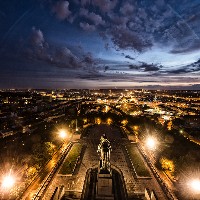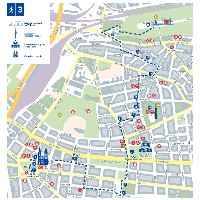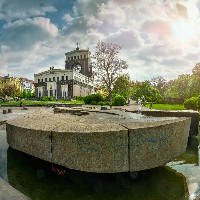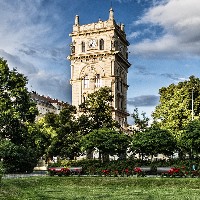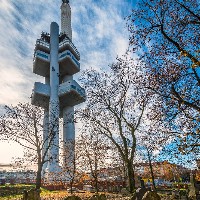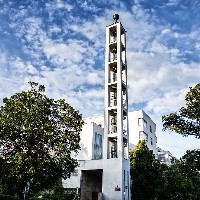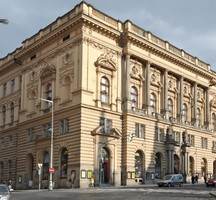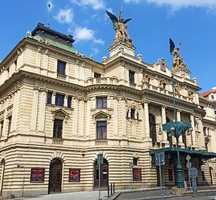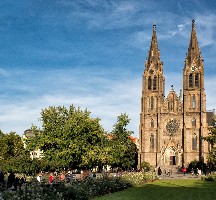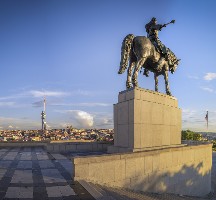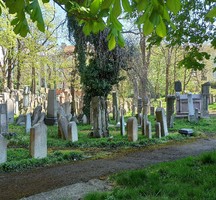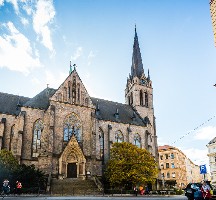Breadcrumbs navigation
From Vinohrady to Žižkov: Searching for Bohemian Prague
Žižkov is one of the most iconic Prague neighbourhoods outside of the historical centre. In the past, its mostly working-class population, lively pubs and cabarets, and hilly terrain under Vítkov Hill together cast an irresistible spell under which many an aspiring artist fell. Žižkov was home to two famous Jaroslavs – Hašek, author of the world-famous humorous novel The Fateful Adventures of the Good Soldier Švejk During the World War, and Seifert, a poet who is the sole Czech Nobel laureate for literature. Today Zižkov is undergoing rapid changes, but its heart remains purely bohemian. The walk will take you first to the Vinohrady district, which gets its name from real vineyards that were laid out on the hillsides here during the Middle Ages. Over time the grapevines were slowly replaced by buildings. In today’s Vinohrady, you'll find beautifully decorated Art Nouveau and Historicist buildings alongside severe Modernism in unusual colours and shapes. This winding route takes you through the streets of Žižkov leading to the TV transmission tower, a modern symbol of this exciting district. Rest and refresh yourself at one of the many local pubs that the district is known for.
- Sports & Relaxation
- walking routes
- TIP
Practical information
ROUTE DESCRIPTION
Route Length: 4 km / 2 miles
1 Náměstí Míru (metro/ tram stiop) → 2 Church of St. Ludmila → 3 Vinohrady Theatre
1. Náměstí Míru
There’s no doubt that náměstí Míru (Peace Square) is the heart of Vinohrady.
2. Church of St. Ludmila
At its centre stands the Church of St. Ludmila, whose 60m high towers dominate the area.
3. Vinohrady Theatre
In stark contrast to its severe Neo-Gothic lines, the Vinohrady Theatre, to the left of the church, catches the eye with its swirling Art Nouveau lines. A few steps from the theatre is the National Building in Vinohrady, a monumental Neo-Renaissance building that’s home to cultural events and restaurants.
→ Slezská St. → Budečská St. → Vinohradská St. →
4. Pavilon
The building of the former Vinohrady Market has graced the neighbourhood since 1903. It’s the result of the rebuilding of a former agricultural machinery factory. Behind its Neo-Renaissance façade lies a spacious interior dominated by the original iron support structure. Today Pavilon is an interior design shopping centre and café.
→ U Tržnice St. → Slezská St. → Šumavská St. → Moravská St. → Dykova St. → 5 Hus Congregational House (Husův sbor)
5. Hus Congregational House (Husův sbor)
A Functionalist building comprising a ceremonial hall, a residential building, and a bell tower. It’s one of Czech architect Pavel Janák’s major projects.
→ U Vodárny St. →
6. Vinohradská water tower (Vinohradská vodárenská věž)
A seven-story tower with a Neo-Renaissance façade and staircase served its function until 1962. It’s said that the statues of trumpeting angels can see the Krkonoš Mountains in good weather.
→ Vinohradská St. →
7. King George of Poděbrady Square (náměstí Jiřího z Poděbrad) (metro/ tram stop)
Arriving on the square, your eyes will be immediately drawn to the unusual monumental architecture of the Church of the Most Sacred Heart by Slovenian architect Jože Plečnik, who was also the creative force behind the modern reconstruction of Prague Castle. The church, whose shape is meant to evoke that of Noah’s ark, is the most important modern religious building in Prague. The square is a frequent venue for a popular farmers’ market as well as other culinary and cultural events.
→ Slavíkova St. →
8. Švehla Dormitory (Švehlova kolej)
The imposing Švehla Dormitory building is evidence of Žižkov’s rich student life. The dormitory was built shortly after the founding of the Czechoslovak Republic in 1918 in national Art Deco style with elements of Rondo-Cubism. It still functions as a home for Charles University students today.
→ Zvonařova St. →
9. Škroupovo náměstí/Square
You might find it hard to believe, but this square measures 150 m (492 ft) in diameter. It entered the Prague history books as the site of the events of the first authorized dissident demonstration in December 1988. Václav Havel gave his first public political speech here, demanding the release of political prisoners.
→ Pospíšilova St. → Fibichova St. → 10 Žižkov Television Tower and Old Jewish Cemetery in Žižkov
10. Žižkov Television Transmitter
A triple tower resembling a spaceship ready for launch is an unmistakable dominant feature of the Prague skyline. In addition to technical equipment, the transmitter tower also houses a luxury single suite hotel, a restaurant with bar and café, and an observation deck with an amazing view of Prague. The transmitter’s columns are adorned with bizarre figures of babies by sculptor David Černý.
Old Jewish Cemetery in Žižkov
Directly under the tower, the Mahler Gardens hide their secrets. At one time, a Jewish cemetery was located here, parts of which are still clearly visible. The old Jewish cemetery in Žižkov was originally part of a plague burial ground of the Prague Ghetto, but over time it transformed into a proper cemetery which served the community for over a century.
→ Fibichova St. →
11. International Telephone Exchange Building
The monumental International Telephone and Telegraph Exchange building is one of the most interesting buildings in Žižkov. It was built shortly after 1921 by architect Bohumír Kozák. Its two towers and other decorative elements are typical examples of Czech national Decorativism.
→ Kubelíkova St. →
12. Palác Akropolis
The cultural heart of Žižkov, Akropolis has a restaurant and multi-genre programme of both established and rising stars. Artist František Skála and architect/playwright David Vávra designed the eclectic interior.
→ Víta Nejedlého St. → Vlkova St. →
13. Sladkovského náměstí/Square
The Church of St. Prokop dominates this picturesque square at the foot of “upper Žižkov” and, along with the nearby Lipanská tram stop, forms one of a number of Žižkov’s focal points. The Neo-Gothic church was built at the turn of the 20th century.
Seifertova St., the main artery of the Žižkov district, is named after Jaroslav Seifert, outstanding Czech poet and Nobel laureate. He not only lived here, but also studied at the nearby grammar school.
→ Seifertova St. → Milíčova St. → Štítného St. →
14. Žižkov Theatre of Jára Cimrman
The Žižkov Theatre occupies an unassuming building at number 520. It has a varied past. The building has been used as a theatre, a chapel, and a renowned dance hall. For many seasons now, however, a theatre group performs here, dedicated to spreading the word of fictitious Czech Renaissance man and unrecognized genius Jára Cimrman.
→ Štítného St. →
15. Kostnické náměstí/Square
Kostnické Square is probably the most picturesque square in Žižkov. It gets its name from the German city of Kostnice (Konstanz), where the church council met in 1415 and sentenced Czech church reformer Jan Hus to death by burning. The name refers to the connection between the Žižkov district and the Hussite events of the 15th century. From the square, there’s an interesting view of Vítkov Hill and the dominant bronze equestrian statue of Jan Žizka of Trocnov.
→ Orebitská St. → Husitská St. →
Husitská St. along with its surroundings is a memorable, yet slightly dark place in Žižkov. During the Middle Ages, gallows were located here.
→ U Památníku St. → 16 National Monument on Vítkov
16. National Memorial on Vítkov (Národní památník na Vítkově)
A dense network of walking and bike paths cloaks Vítkov Hill; take any of them up the hill to the memorial. This monument, with its remarkable Art Deco interior, was originally built to honour the Czechoslovak Legionnaires who fought abroad during World War I and as a mausoleum in which the first Czechoslovak president, Tomáš Garrigue Masaryk, was to be entombed. Today the National Museum’s military history collection is on display here. Together with one of the largest equestrian statues in the world (depicting the legendary Hussite leader Jan Žižka, after whom the entire surrounding district is named), the Vítkov Memorial is one of the visual dominants of the city. The roof, accessible by paying a fee, offers a panoramic view of the city.
Contacts
- From Vinohrady to Žižkov: Searching for Bohemian Prague
- Praha 2, Praha 3 – Vinohrady, Žižkov
Information source: Prague City Tourism

